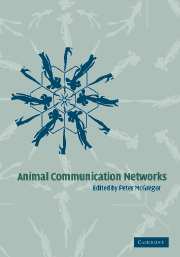Book contents
- Frontmatter
- Contents
- List of contributors
- Preface
- 1 Introduction
- Part I Behaviours specific to communication networks
- Part II The effects of particular contexts
- Part III Communication networks in different taxa
- Introduction
- 12 Waving in a crowd: fiddler crabs signal in networks
- 13 Anuran choruses as communication networks
- 14 Singing interactions in songbirds: implications for social relations and territorial settlement
- 15 Dawn chorus as an interactive communication network
- 16 Eavesdropping and scent over-marking
- 17 Vocal communication networks in large terrestrial mammals
- 18 Underwater acoustic communication networks in marine mammals
- 19 Looking for, looking at: social control, honest signals and intimate experience in human evolution and history
- Part IV Interfaces with other disciplines
- Index
15 - Dawn chorus as an interactive communication network
Published online by Cambridge University Press: 06 August 2010
- Frontmatter
- Contents
- List of contributors
- Preface
- 1 Introduction
- Part I Behaviours specific to communication networks
- Part II The effects of particular contexts
- Part III Communication networks in different taxa
- Introduction
- 12 Waving in a crowd: fiddler crabs signal in networks
- 13 Anuran choruses as communication networks
- 14 Singing interactions in songbirds: implications for social relations and territorial settlement
- 15 Dawn chorus as an interactive communication network
- 16 Eavesdropping and scent over-marking
- 17 Vocal communication networks in large terrestrial mammals
- 18 Underwater acoustic communication networks in marine mammals
- 19 Looking for, looking at: social control, honest signals and intimate experience in human evolution and history
- Part IV Interfaces with other disciplines
- Index
Summary
Introduction
Dawn chorus singing is a striking behaviour pattern, performed by some temperate-zone and tropical songbird species, as well as a few non-passerine and non-avian species. In a typical chorusing songbird species, all territorial males in a neighbourhood synchronously start singing 30 to 90 minutes before sunrise. During the ensuing chorus period, song rate, singing diversity and song complexity reach maximal levels, and often birds do not seem to be interacting with any one particular neighbour (Hultsch & Todt, 1982). Then, as the light level increases around sunrise, this mode of singing usually abruptly ends. Soon after dawn chorus is over, birds begin to forage and patrol their borders, and they switch to courtship singing or dyadic (i.e. paired) counter-singing with nearby neighbours. Post-chorus singing is typically more sporadic and overall song rates tend to be lower and much more variable than they are at dawn chorus (for a review of dawn chorus behaviour, see Staicer et al. (1996)).
Numerous hypotheses have been proposed to explain dawn chorus singing. In an insightful review, Staicer et al. (1996) outlined 12 non-exclusive hypotheses and compared their predictions against the existing empirical evidence across many songbird and non-songbird species. The 12 hypotheses were grouped into three categories: intrinsic, environmental and social. Intrinsic explanations such as circadian cycles of testosterone and self-stimulation are likely proximate mechanisms for dawn singing (Wingfield & Farner, 1993; Goodson, 1998).
- Type
- Chapter
- Information
- Animal Communication Networks , pp. 320 - 343Publisher: Cambridge University PressPrint publication year: 2005
- 60
- Cited by

